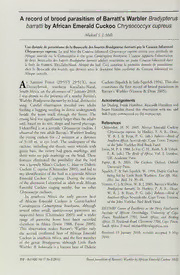
'A record of brood parasitism of Barratt''s Warbler Bradypterus barratti by African Emerald Cuckoo Chrysococcyx cupreus' PDF
Preview 'A record of brood parasitism of Barratt''s Warbler Bradypterus barratti by African Emerald Cuckoo Chrysococcyx cupreus'
2 A record of brood parasitism of Barratt’s Warbler Bradypterus barratti by African Emerald Cuckoo Chrysococcyx cupreus Michael S. L Mills Une donnee de parasitisme de la Bouscarle des fourres Bradypterus barrattipar le Coucou foliotocol Chrysococcyx cupreus. Le seul hote du Coucou foliotocol Chrysococcyx cupreus connu avec certitude en Afrique australe est la Camaroptere a tete grise Camaroptera brachyura. L’auteur rapporte l’observation de deux Bouscarles des fourres Bradypterus barratti adultes nourrissant un jeune Coucou foliotocol dans la foret de Xumeni, KwaZulu-Natal, Afrique du Sud. Ceci constitue la premiere donnee de parasitisme chez la Bouscarle des fourres, qui devient ainsi le deuxieme hote confirme du Coucou foliotocol en Afrique australe. A & t Xumeni Forest (29°55’S 29°51’E), near Cuckoo (Squelch Safe-Squelch 1994). This also Donnybrook, southern KwaZulu-Natal, constitutes the first record of brood parasitism in & South Africa, on the afternoon of7 January 2010, Barratt’s Warbler (Vernon Dean 2005). I was drawn to the presence of a nearby Barratt’s WarblerBradypterus barrattiby its loud, distinctive Acknowledgements song. Careful observation revealed two adults Ian Darling, Frank Hamilton, Ruaraidh Hamilton and feeding a begging nestling in dense undergrowth Stuart Housden shared this observation with me, and beside the main track through the forest. The Bob Payne commented on the manuscript. young bird was significantly larger than the adults and, based on its size, shape and barred plumage, References I identified it as a juvenile Chrysococcyx cuckoo. I Chittenden, H. N. 2005. African Emerald Cuckoo observed the two adult Barratt’s Warblers feeding Chrysococcyx cupreus. In Hockey, P. A. —R., Dean, the young cuckoo for c.2 minutes at a distance W. R. J. & Ryan, P. G. (eds.) Roberts Birds of of 5-10 m, at eye level. The underparts of the SouthernAfrica. Seventh edn. Cape Town: Trustees ofthe John Voelcker Bird Book Fund. cuckoo, including the throat, were whitish with & green bars, the crown had green markings, and Irwin, M. P. S. 1988. In Fry, C. H., Keith, S. Urban, there were no pale markings on the head. These E. K. (eds.) The Birds ofAfrica. Vol. 3. London, UK: Academic Press. features eliminated the possibility that the bird Payne, R. B. 2005. The Cuckoos. Oxford: Oxford was a juvenile Klaas’s Cuckoo C. klaas or Dideric University Press. Cuckoo C. caprius (Chittenden 2005), and led to Squelch, P. & Safe-Squelch, W. 1994. Didric Cuckoo my identification of the bird as a juvenile African being fed by Little Rush Warblers. East Afr. Nat. Emerald Cuckoo C. cupreus. During the course Hist. Soc. Bull. 24: 39-40. of the afternoon I observed an adult male African Vernon, C. & Dean, W. R. 2005. Barratt’sWarbler J. J. Emerald Cuckoo singing nearby, but no other Bradypterus barratti. In Hockey, P. A. R., Dean, Chrysococcyx cuckoos. W. R. & Ryan, P. G. (eds.) Roberts—Birds of J. In southern Africa the only proven host SouthernAfrica. Seventh edn. Cape Town: Trustees of African Emerald Cuckoo is Green-backed ofthe John Voelcker Bird Book Fund. Camaroptera Camaroptera brachyura although , DST/NRF Centre ofExcellence at the Percy FitzPatrick several other small, insectivorous passerines are Institute of African Ornithology, University of Cape suspected hosts (Chittenden 2005) and a wider Town, Rondebosch 7701, South Africa; and Birding range of passerine hosts have been recorded Africa, 21 NewlandsRoad, Claremont7708, Cape Town, elsewhere in Africa (Irwin 1988, Payne 2005). SouthAfrica. E-mail: [email protected] This observation makes Barratt’s Warbler only the second confirmed host of African Emerald Received 19 January 2010; revision accepted 5 May Cuckoo in southern Africa, and the first member 2010. of the genus Bradypterus although Little Rush , Warbler B. baboecala is a known host of Dideric 21 -BullABC Vol 17No 2 (2010) Broodparasitism ofBarratt’s Warbler byAfrican Emerald Cuckoo: Mills
